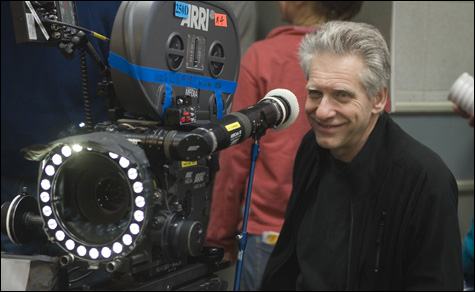
ABOUT THAT BATH HOUSE . . . Cronenberg shows you everything. |
Some who’ve watched the on-line videos of al-Qaeda executions may suffer a shock of recognition at some images in Eastern Promises. “I have seen some, one,” says David Cronenberg. “And it was definitely in my mind when I did that scene. There is now snuff on the Web for anybody to see anytime, and this is a pretty new development. And it’s obviously very disturbing, and I definitely had that in mind when I was doing those scenes.”On-line snuff films may be a new development, but they were foreseen back in 1983 in Cronenberg’s Videodrome, in which James Woods plays an entrepreneur who discovers a television station that broadcasts real-life torture and executions. Watch them at your own risk, however; they have a transformative power, turning viewers into a fusion of technology and humanity — “the new flesh.”
So now that the snuff-TV concept is a reality, what does he think the effect will be on those who watch?
“I think they’re more sensitized, because I think it’s come much closer to home. It’s come into your home on your computer. In the old days, it was all stuff that happened far away, and you heard about it, or maybe you saw a gruesome photograph, but usually not. And now you can look at it at three in the morning if you want, in your house. And it’s American citizens, often, in countries that seem to be unfathomable in some ways, the mentality that’s involved. And you have people doing these things thinking that they’re committing sacred acts, and to you it’s like a heinous, hideous atrocity. And where do those cultures come together? So I think people are more sensitive to violence on screen now, not less.”
How, then, does he explain the popularity of the hyper-graphic violence in Saw and Hostel?
“Well, I wonder — and I haven’t seen them, so I can’t get too specific — I wonder if that’s not a reaction [to images of real-life violence]. That you want to confront what scares you in a controlled environment, which is a movie theater. Certainly, that’s always been an aspect of horror films. Why do people want to be scared? Well, there is a need to confront things that scare you, but you want to walk away from it. Even just scenes of violence on the street, for example: people read about it all the time, and they worry about it, and they wonder what it would be like, and how they would react. And the [way of] exercising and exorcising that is to see a movie in which there are scenes like that. And you get a chance to experience it at a distance in a safe way. I think the main reason, really, that people go to see a movie is to live another life for a moment — not necessarily a life that you’d want to be your own, but that you’re curious about.”
Hence the bath-house scene, the most controversial sequence in Eastern Promises. The general response has been utter discomfort and total fascination.
“It’s like that shower scene in Psycho. You’re naked, you’re wet, and there are guys with knives who don’t like you. You can’t be more vulnerable than that. That’s why I showed that bath scene, not in a Bourne-movie kind of impressionistic, quick-cutting way where you don’t really see what’s going on, but where you saw everything that was going on. Because if you’re going to be Nikolai for the time of this movie, following this character, or as we used to say, identifying with him, I want you to have his experiences. So I feel like I would be cheating my audience to do it off camera, or out the window, or some other way.